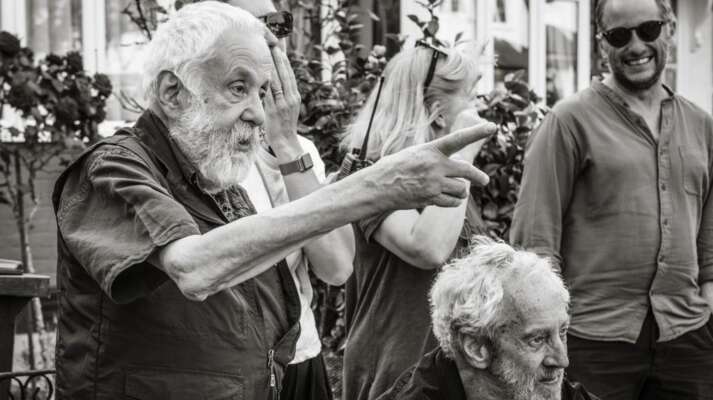Actors We Love: Viggo Mortensen
From king to “Captain,” Viggo Mortensen brings his all to every role
Actors We Love: Viggo Mortensen
Written by Peter Bowen
Captain Fantastic | A Family Hero
In Matt Ross’ CAPTAIN FANTASTIC, Viggo Mortensen plays Ben Cash, a devoted father raising his brood of six children on his own in the wilds of the Pacific Northwest. For the filmmakers, Viggo Mortensen was the perfect actor to play the rugged father who dedicates himself to changing the lives of his kids. For Ross, “physically and temperamentally, he was absolutely right.” But even more, Mortensen “exemplifies a very high level of artistry and integrity. That is one of the things that made him my first choice to play Ben,” explains Ross. Indeed, Mortensen brought more than his talent to set. As a father, he brought his personal experience. As a poet, musician, photographer, and painter, he provided an additional aesthetic influence to the film’s look and feel, even contributing his own original music to the production. He went so far as to loan his own possessions to the production design to give the character and his home a sense of realism. “I like to offer up things of my own that might be appropriate,” Mortensen recounts. “Many of the books you see on the bus and in our home are books I brought. There’s also my canoe, some bicycles, things from the kitchen, knives and clothes. I brought a lot of plants for the garden near the tipi.” Like the character he plays, a man who practices his principles in all his affairs, Mortensen shows up to every film bringing everything he has. In CAPTAIN FANTASTIC that dedication translates into a performance that fully captures the character on the page. For The Guardian’s Brian Moylan, “Mortensen, looking his most mountain-man handsome, is winning and charismatic.”
A Walk on the Moon | A Presence to Behold

From his first appearance on screen in Peter Weir’s 1985 thriller Witness, Viggo Mortensen captured the public’s imagination. Although cast in a small part as a quiet, sturdy Amish man, Mortensen’s presence was felt by audiences everywhere. Getting ready to cast his new film, Sean Penn needed only to see that look to know he wanted the actor. “The television was on, sound off, and I saw a face: he was only a cameo in a movie, but I saw the face that I'd had in my head when I wrote Indian Runner,” Penn recalls. Eventually the producers tracked down the actor to offer him a leading role in the film. “Viggo's inherent kindness as a guy showed in a sort of languid movement,” recalls Penn. “And that was a lesson for me about what parts of people express themselves without trying." But Mortensen was just as adept in capturing the despair and depth of human expression as its nobility. In praising his turn as the wheelchair-bound snitch in Carlito’s Way, Esquire’s Jeremy Wheeler notes that “with just minutes of screentime, [Mortensen] levels the playing field with a performance that couldn't be more different from the quiet cool that he's known for now.” When Tony Goldwyn was casting the pivotal role of the Blouse Man in A Walk on the Moon, he needed a figure whose presence alone could inspire fantasies of all sorts. “I realized there is not one other actor anywhere who could play Viggo's part other than Viggo,” remembers Goldwyn. “He has this kind of complexity and mysteriousness to him. He doesn't have to say much and you get a lot." Pointing out that the film was “originally called The Blouse Man in honor of its traffic-stopping title character,” The New York Times critic Janet Maslin praises how the character is “played with silky eroticism by Viggo Mortensen.”

The Lord of the Rings | The Coronation of a Star
While millions of The Lord of the Rings fans were enthralled with the possibility of Middle-earth coming to a theater near them, Viggo Mortensen was only vaguely aware of Tolkien’s precious world when he received an urgent phone call in 2000 asking him to consider taking on the role of Aragorn. The filmmakers had to replace Stuart Townsend whose youth they quickly discovered did not capture the gravitas of Tolkien’s great warrior. Luckily for the world, Mortensen’s 11-year-old son Henry was a big fan of the fantasy classic and pushed his Dad to get on a plane to New Zealand to meet director Peter Jackson and the rest of the production team. Once he signed on, Mortensen threw himself into the role with his characteristic enthusiasm and dedication. He even used his own uncertainty about taking the part to fathom his character’s psychology. Aragon “feels the weight of other people's expectations,” Mortensen told The Independent. “I felt that in Aragorn, and I felt it too as an actor: 'You've hired me 'cos you think I can do it but privately I'm not sure'." But if Mortensen was at all uncertain, his cast members were the opposite. "I bow down to Viggo. He came in and saved the day," Elijah Wood told Entertainment Today. “They called him, he came and it was perfect. He was meant to play Aragorn; he is Aragorn." On set he exhibited all the virtues of the fictional king. He carried a real steel sword, rather than the lightweight aluminum ones provided by the prop master. And his natural skill at wielding it was such that Olympic fencer Bob Anderson, who’d been hired to tutor the cast, later described Mortensen as “the best I have ever trained.” Mortensen may have been a last minute addition, but over the length of the trilogy––The Fellowship of the Ring (2001), The Two Towers (2002) and The Return of the King (2003)––the actor soon ascended to become the film’s soulful center. Rolling Stone’s Peter Travers exclaimed, “Mortensen, in the film's best performance, brings heroic stature to Aragorn, befitting a man descended from kings. Aragorn's conflict with Boromir, given haunting complexity by Bean, strikes at the essence of brotherhood and roots the film in emotion.”
A History of Violence | Deceptively Complex

In David Cronenberg’s 2005 thriller A History of Violence, loosely adapted from John Wagner’s graphic novel of the same name, Viggo Mortensen is cast as Tom Stall, a diner owner and family man whose existence and identity is torn asunder when he kills two men who attempt to rob him. While Stall’s decisive action initially turns him into a hometown hero, it also shines a light on a violent past that he’d hoped to keep buried. In casting the lead, Cronenberg needed an actor whose presence and personality could suggest two things at once: both family man and violent aggressor, both solid citizen and dangerous criminal. In picking Mortensen, Cronenberg was persuaded as much by his romantic work, like his part in A Walk on the Moon, as by his action roles. “Usually he plays bad guys or scary guys, but I could see from that movie he could be very lovely as a gentle, sweet guy and very sexy as well,” Cronenberg told About.com. For Mortensen, the part offered a rare creative challenge. “I think that we're all multiple personalities,” Mortensen told In Contention’s Kristopher Tapley: “Any person can think anything…They are capable of beautiful, noble sentiments as much as they are of very dark and troubling thoughts.” Working with Cronenberg, Mortensen physically crafted a character who not only contained multiple layers, but whom audiences would read differently depending on the context. “When first seen, Mortensen's Tom is the Honest Abe Lincoln of coffee shops; the flesh clings so tightly to his bones, you'd think there'd be no room to conceal anything,” The Nation’s Stuart Klawans vividly remarks. “Later, when this man begins to change, Cronenberg bets the movie on Mortensen's ability to bring depth to a face that you thought was all surface.” But Mortensen’s performance takes the illusion even further, brilliantly playing with our assumptions about Hollywood violence as well as the character of a movie star and leading man. “There's a skittery kind of unease under Tom's bland, all-American everyman exterior that could be read in several ways, all of them directly contradictory to the others,” Flick Filosopher points out. “You simply cannot predict what Tom will turn out to be because, thank the movie gods, there is no ‘Viggo Mortensen’ screen persona: he's too vastly different every time he appears on film.”
Eastern Promises | Finding the Dark Side

After collaborating so successfully on A History of Violence, Viggo Mortensen and David Cronenberg reunited in 2007 to make Eastern Promises. Like with A History of Violence, Eastern Promises plays with audience assumptions, presenting Mortensen as Nikolai Luzhin, a rising star in the Russian mafia in London, but also hinting that people are never exactly as they appear in this world. Only when a British-Russian midwife (played by Naomi Watts) steps on dangerous toes in her determination to discover the truth about a teenage girl who dies in childbirth does Mortensen begin to reveal himself. The essential nature of his character may have been elusive, but Mortensen worked hard to bring profound reality to his performance. “I've never met anyone like Viggo who throws himself into a role body and soul,” Cronenberg told the Chicago Sun Times. “He will study like he's getting a PhD in the character.” Indeed, Mortensen spent six months, not only learning the language, but also immersing himself in the culture by studying Russian novels and philosophy. He spent several weeks just experiencing Russia on its own terms. “I wanted to see things on my own, to stumble around in Moscow, St. Petersburg, and then out in the middle of the country, where I wanted to see what impressions I got,” Mortensen told PopEntertainment.com’s Brad Balfour. To fathom the complex criminal subculture, he learned about the secret language of Russian prison tattoos to such an extent that he became a consultant on Alix Lambert’s documentary The Mark of Cain. For the film, Mortensen transformed his months of preparation into building his character, a complex and contained man whose feelings and emotions flash forth in brief but explosive moments. “The immovable hair and the deep dimple in his slightly crooked chin suggest a young Kirk Douglas, but Mr. Douglas was never this quiet,” describes The New York Times’ A. O. Scott. “He is all hard, tense muscle, and yet an almost subliminal hint of compassion occasionally shines through his icy, impassive face.” Refining his minimalist style, Mortensen showcased an intellectual performance that critics applauded. “Mortensen is absolutely brilliant,” exclaims The Oregonian’s Shawn Levy. “Stoic and sarcastic and threatening and, at moments, curiously soft.” At the same time, the film’s most talked about scene, a bloody violent knife fight at a Russian bathhouse, demonstrates that Mortensen’s performance is anything but cerebral. As Slate’s Dana Stevens exclaims, comparing it to his previous fights scenes, “till you've seen him do it buck naked and covered in mob tattoos, you haven't lived.” And come award season, his peers recognized his clothed and unclothed turn when he received multiple laurels, including an Academy Award nomination.

The Road | Finding the Father
In 2009, Viggo Mortensen appeared in John Hillcoat’s The Road, an adaptation of Cormac McCarthy’s Pulitzer Prize-winning novel of the same name. The dark film recounts the journey of a father (Viggo Mortensen) and his son (Kodi Smit-McPhee) through a post-apocalyptic landscape on their way to a future that remains forever obscure. To develop the character of the Father, a man as filled with anxiety about his son’s future as he is lacking food and supplies, Mortensen had to engage in a severe training and weight-loss program. “But the physical stuff was only a means to an end,” Mortensen told the Kansas City Star. “The cold, the wet, the hunger ... all that helped us to get to another place. An emotional place.” Part of that emotional state for him was to connect to his own reality as a dad. “It's really about protecting your child, no matter what the circumstances,” Mortensen told USA Today. “At its core, it's a love story." For many critics, Mortensen’s unique talent for conveying multiple states at the same time brought a glint of humanity to this dark allegory. “A surpassingly quiet and thoughtful actor, he specializes in making improbable characters—a Middle Earth warrior in Lord of the Rings, a Russian mobster in Eastern Promises, a small-town dad with a secret in A History of Violence—seem like natural extensions of his own personality,” notes The New York Times critic A. O. Scott.


